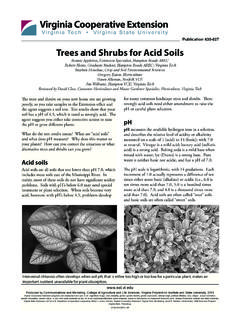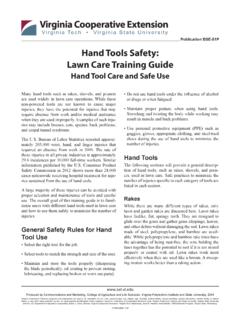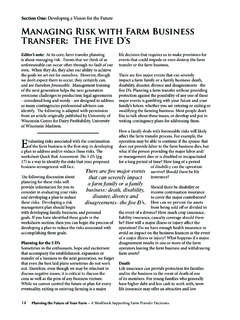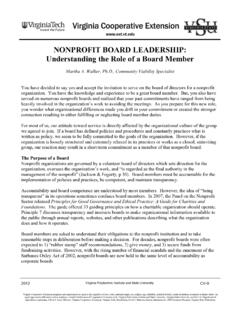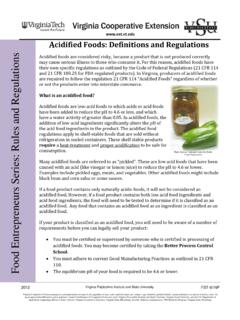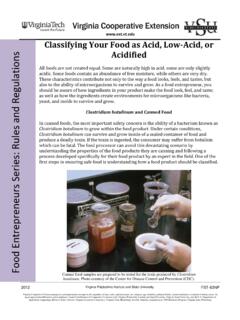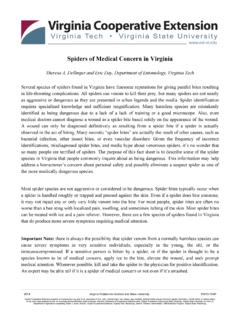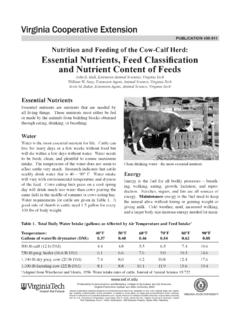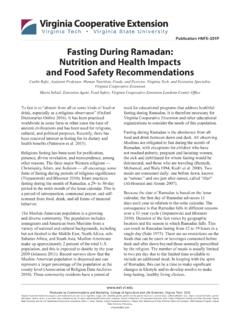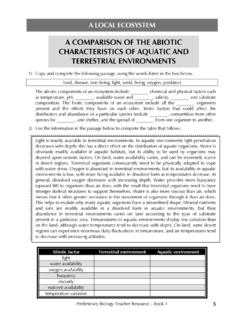Transcription of Aquatic Habitats: Homes for Aquatic Animals - Virginia Tech
1 Natural Aquatic habitats include ponds, lakes, rivers, streams, springs, estuaries, bays, and various types of wetlands. Some of these habitats are shallow and others deep, some are cold-water and others warm-water, some are freshwater and others saltwater, and some have high oxygen levels and others little habitats can be classified as: non-flowing waters like lakes and ponds, slowly-flowing waters like marshes and swamps, and flowing waters like rivers and pond is a small (usually less than ten surface acres in size), shallow depression in the earth filled with water from rain or snow-melt runoff, springs, or groundwater.
2 Ponds can lose wa-ter through seepage, evaporation, or transpiration (plant respira-tion).Because ponds are shallow in depth, sunlight penetra-tion into the pond encourages abundant growth of bottom-rooted plants such as pondweed and milfoil, and floating-leaf plants like water lily and duckweed. Ponds often are fringed with emergent bulrushes and cattails. Water temperature in ponds is similar from top to bottom. Dissolved oxygen levels may vary greatly over a 24-hour day. Ponds are rich in plants and algae that serve as the foundation of the food chain for insects, fish, and other forms of lake is larger and deeper than a pond.
3 Lakes can range in size from small (ten surface acres) to large (the Great Lakes: Erie, Michigan, Huron, Ontario, and Superior). Three areas in the United States with abundant lakes are: the glacier-formed Great Lakes and those in Minneso-ta, Wisconsin, and Michigan; the limestone sinkhole lakes in Florida; and the mountain lakes in the are too deep for water plants to grow except around the shoreline. Water tempera-ture layering occurs as cooler (denser) water sinks to the bottom in the summer.
4 Dissolved oxygen layering also occurs as oxygen-poor waters are found on the bottom in summer. Lakes provide abundant fish and wildlife (marshes, swamps, bayous, and bogs) generally are shallow, low-lying areas (near the water table) with fluctuating water levels. The soils are wet most of the year and they support an abundance of Aquatic America s Aquatic BiodiversityAquatic Habitats: Homes for Aquatic AnimalsLouis A. Helfrich, Department of Fisheries and Wildlife Sciences, Virginia TechJames Parkhurst, Department of Fisheries and Wildlife Sciences, Virginia by Communications and Marketing, College of Agriculture and Life Sciences, Virginia Polytechnic Institute and State University, 2009 Virginia Cooperative Extension programs and employment are open to all, regardless of race, color, national origin, sex, religion, age, disability, political beliefs, sexual orientation, or marital or family status.
5 An equal opportunity/affirmative action employer. Issued in furtherance of Cooperative Extension work, Virginia Polytechnic Institute and State University, Virginia State University, and the Department of Agriculture cooperating. Rick D. Rudd, Interim Director, Virginia Cooperative Extension, Virginia tech , Blacksburg; Alma C. Hobbs, Administrator, 1890 Extension Program, Virginia State, 420-522 2 Wetlands once were considered useless lands to be used only as dumpsites or drained, ditched, and dredged for farming and building sites.
6 Today we know that wetlands are valuable lands that support a rich biodiversity of waterfowl, songbirds, turtles, frogs, fish, and other wildlife. They act as natural sponges, absorbing rain water and preventing are grassy wetlands dominated by cat-tails, bulrushes, pondweeds, and floating-leaf plants like the water lily. They can vary in size from a small wet meadow to thousands of acres like the Everglades in Florida. Lakeside and riverside marshes slow soil sediment runoff and protect water quality.
7 Wildlife and fish nest and rear their young in these important nursery marshes occur along our coastal areas. They are dominated by salt-tolerant plants like cord grass and are greatly influenced by tides. Among our most pro-ductive wildlife habitats, salt marshes are important feeding and nursery areas for fish, shellfish, crabs, and are woody wetlands dominated in the North by trees like willows, alders, and maples, while in the South bald cypress, tupelo gum, and oaks dominate. Swamps often are wet part of the year and dry the remainder of the year.
8 If they remain wet too long, the trees may die, and most swamps have standing dead bottomland hardwood swamps oc-cur along big rivers like the Mississippi River and are important for flood control because they slow downstream peak flows. They pro-vide valuable nesting and resting places for waterfowl and other wildlife. Wood ducks, for example, nest in dead, hol-low trees in are areas where groundwater flows upward to the surface. They may range in size from tiny seep holes with only enough water to form a small puddle to large spring streams flowing at a rate of 1,000 gal-lons per flows are dependent on enough rainwater filtering into the soil and rock in an area and filling up the underground aquifer.
9 Springs continuous flows of clear, cool, high-quality water year-round provides habitat and refuge for many unique Aquatic Animals , especially during hot weather or droughts. Moist soil and lush vegetation along stream banks (called riparian areas) offer food, shelter, and water for songbirds and many other forms of wildlife. They are important travel corridors for most wildlife mov-ing from one area to and streams are flowing water systems con-tained within a channel bounded by : Much of the annual flow in streams and riv-ers is provided by groundwater (natural spring seeps) that, in turn, is replenished by rainwater.
10 Because water seeps slowly through the soil, the surface water flowing in streams can represent rainwater that fell days, weeks, or even months before. This regular, continuous seepage of groundwater that keeps streams flowing is called base flow, low flow, or minimum velocity is regulated by gravity (steepness of the slope), friction (roughness of the bottom and banks), and water and Riffles: Natu-ral streams are composed of two dominant habitat types: pools and riffles. A pool is an area of deep, slow water; a riffle is an area of shallow swift water.
